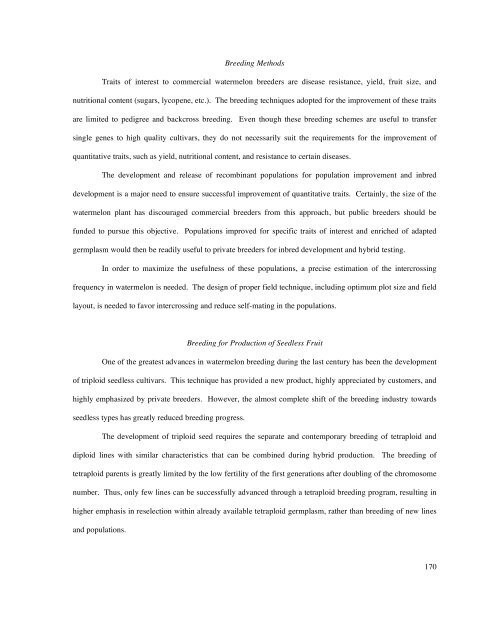Citrullus lanatus (Thunb.) Matsum. & Nakai - Cucurbit Breeding ...
Citrullus lanatus (Thunb.) Matsum. & Nakai - Cucurbit Breeding ...
Citrullus lanatus (Thunb.) Matsum. & Nakai - Cucurbit Breeding ...
You also want an ePaper? Increase the reach of your titles
YUMPU automatically turns print PDFs into web optimized ePapers that Google loves.
<strong>Breeding</strong> Methods<br />
Traits of interest to commercial watermelon breeders are disease resistance, yield, fruit size, and<br />
nutritional content (sugars, lycopene, etc.). The breeding techniques adopted for the improvement of these traits<br />
are limited to pedigree and backcross breeding. Even though these breeding schemes are useful to transfer<br />
single genes to high quality cultivars, they do not necessarily suit the requirements for the improvement of<br />
quantitative traits, such as yield, nutritional content, and resistance to certain diseases.<br />
The development and release of recombinant populations for population improvement and inbred<br />
development is a major need to ensure successful improvement of quantitative traits. Certainly, the size of the<br />
watermelon plant has discouraged commercial breeders from this approach, but public breeders should be<br />
funded to pursue this objective. Populations improved for specific traits of interest and enriched of adapted<br />
germplasm would then be readily useful to private breeders for inbred development and hybrid testing.<br />
In order to maximize the usefulness of these populations, a precise estimation of the intercrossing<br />
frequency in watermelon is needed. The design of proper field technique, including optimum plot size and field<br />
layout, is needed to favor intercrossing and reduce self-mating in the populations.<br />
<strong>Breeding</strong> for Production of Seedless Fruit<br />
One of the greatest advances in watermelon breeding during the last century has been the development<br />
of triploid seedless cultivars. This technique has provided a new product, highly appreciated by customers, and<br />
highly emphasized by private breeders. However, the almost complete shift of the breeding industry towards<br />
seedless types has greatly reduced breeding progress.<br />
The development of triploid seed requires the separate and contemporary breeding of tetraploid and<br />
diploid lines with similar characteristics that can be combined during hybrid production. The breeding of<br />
tetraploid parents is greatly limited by the low fertility of the first generations after doubling of the chromosome<br />
number. Thus, only few lines can be successfully advanced through a tetraploid breeding program, resulting in<br />
higher emphasis in reselection within already available tetraploid germplasm, rather than breeding of new lines<br />
and populations.<br />
170
















